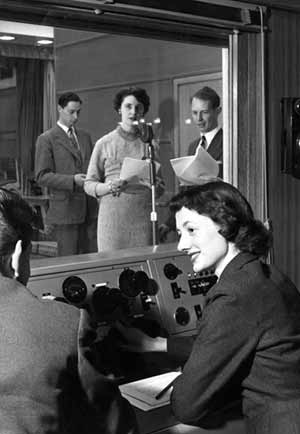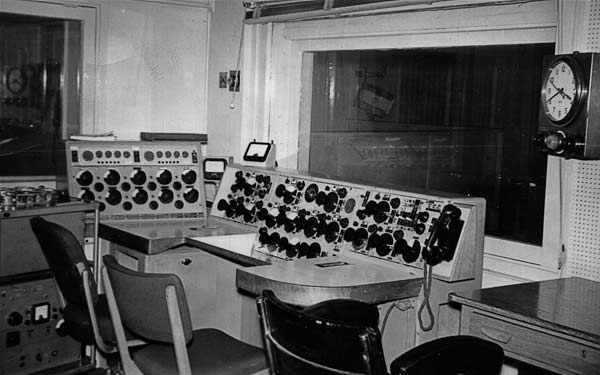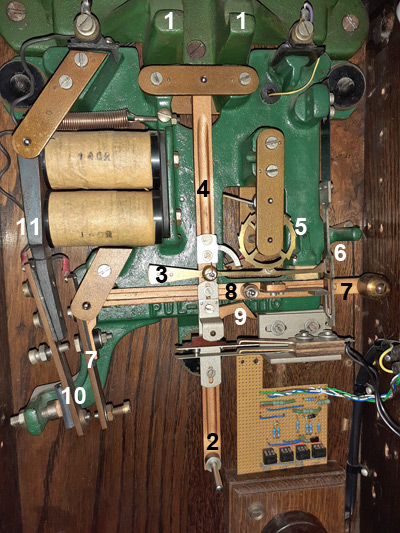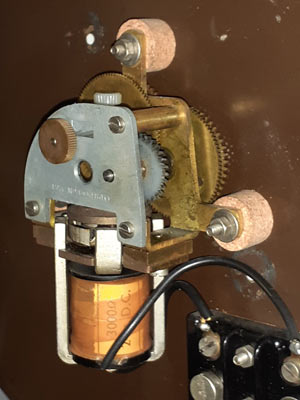
Studio 2 in 1957
Until Studio One’s refurbishment in the mid-1960s, both studios were equipped with Type A consoles, which were adequate for the sort of drama and early Variety productions for which they were intended, but not large enough to cope satisfactorily with the increasing demands of the 1960s Light Entertainment productions with orchestras and singers.

Type A desk in cubicle of Studio 1, date unknown
There were 20 faders in three groups – 10 blue, 5 red and 5 green, plus two independents (which didn’t have any echo sends and were therefore completely useless for vocals). The one good point about the new design was the excellent sight line into the studio, but there were a great number of bad points. The controls above the faders were not, as would have been useful, echo mixture switches – they were cue light selectors. Utterly utterly irrelevant in a PM & LE studio. The echo mixture switches were in a panel to the left, in two rows, and following engineering practice channel one was at the left of the bottom row, not the top row as operational logic might dictate. There were not enough RSAs for one per channel, so 10 were provided, taking two panels to the left of the SM. RSA 1 was furthest away, and there was room for 7 units per panel, so they were mounted 1-7, 8-10 with blanks in the remaining positions – nearest to the operator. The jackfield was also on the SM’s left – at floor level! Following engineering practice, of course, channel one was bottom left, literally an inch above the floor, and the only way to plug up the jackfield was to lie on the floor.
Studio One was used regularly for Light Entertainment shows with an audience; there were two 4038 microphones slung about 8 feet or so above each of the two banks of seats. These proved to be a highly attractive target for George Harrison during a Beatles recording session in 1963, as he smoked Stuyvesant cigarettes which came in the American style soft pack carried in a thin steel non-crush sleeve. The guitar amps were miked with 4038s and George soon discovered that they were magnetic, and then realised that they were the same type that was slung overhead. Being bored and inherently mischievous he started to throw the steel packet holder up in the air to try to stick it onto one of the audience mics, despite the desperate pleadings of the junior SM (John Andrews) who was horrified at the thought of having to explain how he’d let it happen, as there appeared to be no easy way to lower the microphones and they were over the seating making using a step ladder a difficult proposition. Luckily George’s aim wasn’t good enough and he soon gave up.
Robert Smith describes his souvenir of the Piccadilly studios

When the BBC vacated the premises in Piccadilly they were taken over by Command Studios until they ceased trading as a recording facility in the mid 1970s. At the closing down sale was Geoff Woodward, the Chief Engineer for Radio Trent in Nottingham, who was just building their studio centre on Castle Gate prior to going on air in July 1975.
Amongst several items Geoff was able to buy was the Gents master clock which kept accurate time for Radio Trent until the mid 1980s when they upgraded to a Gents crystal driven system. By that time I was working at Leicester Sound, a subsidiary of Radio Trent, and Geoff kindly allowed me to have the redundant clock so its provenance is assured, albeit on the word of Geoff which I have no cause to doubt. Strictly speaking, the mechanism is not an escapement in the conventional sense which allows the hands of the clock face to advance at a controlled rate but a mechanical device which generates an electrical signal which drives the slave clocks. The pendulum has a period swing of exactly two seconds. Originally developed for church tower clocks and the travel industry every railway station in the country had one generating a pulse every thirty seconds. This drove several electrically connected slave clocks sited around the station advancing their minute hands by half a minute in synchronism.
For broadcasters, by simply adding a seconds contact to the master clock mechanism with each swing of the pendulum the contacts would first be closed for one second and then open for one second.

The pendulum hangs on two short arms (1) cast with the backing plate and swings
on a short length of sprung steel strip rather than a pivot. A pin (2) at
the bottom of the mechanism engages in a vertical slot milled into the pendulum,
just visible below the clock face.
A pivoted driving pawl arm (3) on the pendulum follower (4) advances a wheel with fifteen ratchet teeth (5) by one tooth at each swing. One tooth on the wheel is slightly deeper than the other fourteen allowing the pawl on the pivoted arm to push a restraining bar and catch (6) clear of a gravity lever (7). This then drops giving the pendulum a slight push by a roller (8) mounted on it acting on the inclined face of an impulse pallet (9) fixed to the pendulum. This is the only energy imparted to the pendulum. The L-shaped gravity lever is then electrically reset through two closing contacts (10) by a solenoid (11) and so the action continues.
A pivoted driving pawl arm (3) on the pendulum follower (4) advances a wheel with fifteen ratchet teeth (5) by one tooth at each swing. One tooth on the wheel is slightly deeper than the other fourteen allowing the pawl on the pivoted arm to push a restraining bar and catch (6) clear of a gravity lever (7). This then drops giving the pendulum a slight push by a roller (8) mounted on it acting on the inclined face of an impulse pallet (9) fixed to the pendulum. This is the only energy imparted to the pendulum. The L-shaped gravity lever is then electrically reset through two closing contacts (10) by a solenoid (11) and so the action continues.

Although the system is designed for 24 volts DC my clock is running reliably on 19 volts from an old lap-top computer power supply. Initially I fitted the clock with a relay to convert the simple open and close seconds contacts to reverse the supply to the clock motor but, being a mechanical device, it eventually failed. Following a house move the clock remained inactive for many years but it has now been installed in our dining room and I have built a small unit to convert the simple seconds contact closure to reverse the supply polarity to the clock face using four solid state, and silent, optically isolated relays.

Gents, now Honeywell Gent, is a Leicester company, of course, but, sadly,
when I contacted them I was told that they had destroyed all the records of
where each of their clocks had been installed so I was unable to find out
any more about the timepiece.
It is a joy to have the clock on our wall in Hinckley with its gentle friendly clonk every thirty seconds as the gravity lever resets!
It is a joy to have the clock on our wall in Hinckley with its gentle friendly clonk every thirty seconds as the gravity lever resets!
If you have memories or photos of these studios which could be added to this page please get in touch using the 'Contact' link below.

